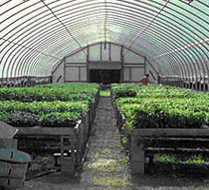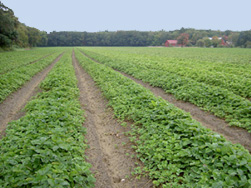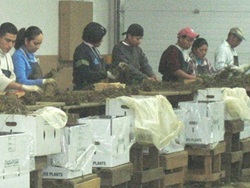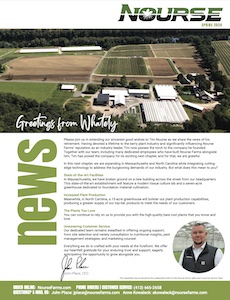- Viruses cause decline in plant vigor and fruit production
- Viruses are transmitted by insects, nematodes, pollen and certain propagation practices
- To produce the best quality planting stock, it is necessary to begin with indexed virus free plant material
- Indexing is a means of detecting virus
PlantPropagation
Virus Indexing
Methods of virus indexing at Nourse Farms
Indicator Plants
- Indicator plants are so called because they express virus infection visually by exhibiting strong symptoms in their leaves and/or growth habit
- Indicator plants are a good general virus screen because they detect the presence of virus in your plant but not necessarily which virus
- Nourse uses sap inoculation and grafting techniques to virus screen their stock plants on indicator plants
ELISA
- ELISA stands for enzyme-linked immunosorbent assay
- ELISA is a laboratory test that uses antibodies made to specific plant viruses and an enzymatic color reaction to detect virus in the plant
- ELISA is more sensitive than indicator plantsELISA tests are specific for each individual virus unlike the general virus detection of indicator plants
PCR
- PCR stands for polymerase chain reaction
- PCR tests are laboratory tests that detect the presence of plant viral DNA or RNA in the stock plant
- PCR tests are more sensitive than indicator plants and like ELISA tests, each PCR test is specific for an individual virus
Tissue Culture
Tissue culture or micropropagation is a method of propagating plants from the tiny growing points or meristems in the buds or shoot tips of a plant. This process is possible because each cell contains the genetic material necessary to regenerate an entire plant.
There are four stages of tissue culture propagation:
Stage I - Under sterile conditions in the laboratory, the growing point of the plant, such as a shoot tip or bud, is excised from the stock plant and placed into a simple growth medium where it develops into a tiny plantlet.
Stage II - The stage I plantlet is transferred into a different growth medium containing plant hormones that will encourage the plantlet to produce more plantlets. In this stage, the number of plantlets is increased through a series of transfers to fresh medium. This process continues until the desired number of plantlets is produced.
Stage III - The stage II plantlets are transferred to another different medium that will prepare them for transfer to a greenhouse environment.
Stage IV - The stage III plantlets are removed from stage III medium and planted in a greenhouse where they root and acclimate to the greenhouse environment.
Greenhouse Production
- Stage IV plantlets are rooted, acclimated, and grown on to a field–ready plug plant. This process takes 8 – 12 weeks.
- These plug plants are the foundation stock for our strawberry and raspberry nurseries. Certain raspberry plug plants are also sold directly to the customer.
- Our plug plants are finished off as either dormant plugs, hardened – off green plugs or nursery – matured plants.

Lab

Greenhouse

Field Production

Packhouse



